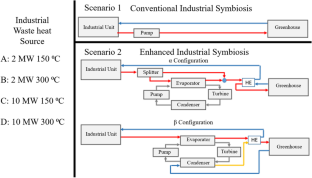The effect of organic Rankine cycle system design on energy-based agro-industrial symbiosis
Abstract
Industrial symbiosis (IS) is known as an effective strategy to reduce resource consumption. Recently, the utilization of efficient energy conversion technologies in symbiotic relations has been suggested to enhance the flow exchange efficiency and economic effectiveness of energy-based industrial symbiosis schemes. In this work, the possibility of improving industrial symbiosis between agricultural greenhouses and waste heat sources in industries is investigated by utilizing the organic Rankine cycle (ORC) in different configurations. For this aim, a modelling tool is developed to analyse the thermo-economic justification of energy-based industrial symbiosis and estimate the possibility of simultaneous waste heat utilization for power generation and greenhouse heating. The results show that the selection of working fluid, capacity and configuration has a significant effect on the successful implementation of ORC technology and can reduce the payback period time to less than 5 years for the proposed case study. However, results indicate that even using an optimized ORC system is not always accompanied by improving the economic effectiveness and justification of IS establishment.



 求助内容:
求助内容: 应助结果提醒方式:
应助结果提醒方式:


